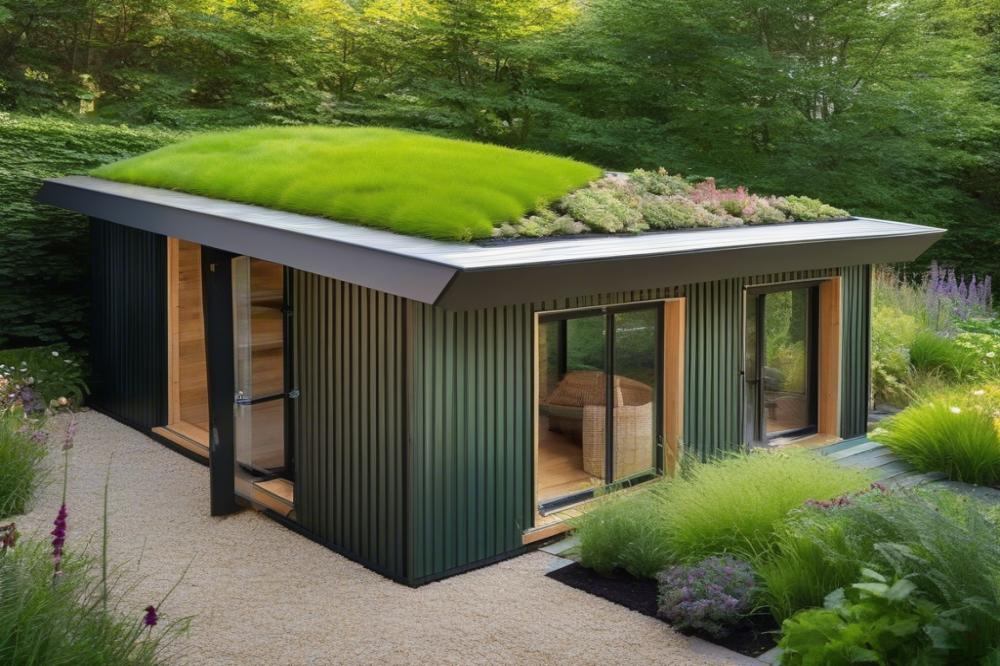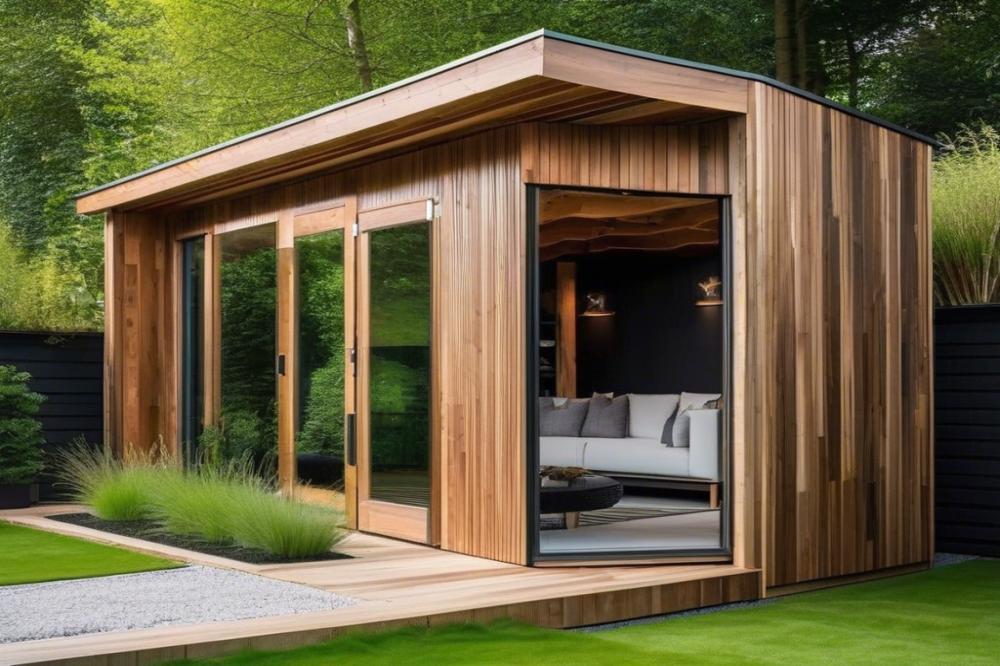Creating Eco-Friendly modern sheds with green roofs
In recent years, there has been a noticeable rise in the popularity of eco-friendly sheds. These structures provide practical outdoor spaces while being mindful of the environment. Homeowners are increasingly seeking ways to combine functionality with sustainability. This trend reflects a broader movement towards sustainable design in modern architecture. Creating spaces that reduce energy consumption and lessen environmental impact is essential.
Many people now understand the importance of using eco-friendly materials. Traditional building methods often overlook the effect of human activity on nature. For instance, eco-friendly sheds can incorporate solar panels or rainwater harvesting systems. This approach helps in energy efficiency, making these structures more beneficial for the environment. Additionally, gardening can be seamlessly integrated into these spaces, further connecting people with nature.
green roofs are another innovative feature that enhances these modern constructions. They provide natural insulation, helping to maintain a comfortable temperature inside. Moreover, such roofs contribute to biodiversity by supporting various plant species and insects. When people think about their outdoor spaces, they often envision areas that promote well-being. Combining landscaping with sustainable design offers just that.
In short, the growing interest in eco-friendly sheds with green roofs signifies a shift towards a more sustainable future. By adopting these practices, individuals can enjoy the beauty of nature while minimizing their ecological footprint. Choosing smart designs benefits personal enjoyment and showcases a commitment to protecting our planet.
Understanding Eco-Friendly Sheds

Eco-friendly sheds are structures designed with the environment in mind. Their primary goal is to reduce the negative impact on the planet. These buildings prioritize sustainable design, using materials and methods that support environmental health.
Several characteristics define these modern structures. Natural insulation helps to maintain comfortable temperatures inside. Also, energy efficiency is a key feature, allowing for minimal energy use. Many designs include features like rainwater harvesting systems, which collect water for gardening or other uses. Additionally, the presence of green roofs encourages biodiversity, providing habitats for insects and birds.
The role of eco-friendly materials cannot be understated. Choices like reclaimed wood, bamboo, or recycled metal contribute to sustainability. By selecting materials wisely, builders can lessen their carbon footprint. modern architecture incorporates these materials into stylish designs, proving that eco-consciousness does not sacrifice aesthetics. Such choices not only benefit the environment but also enhance the look of outdoor spaces.
Numerous examples illustrate what eco-friendly sheds can achieve. Some designs function as garden studios or workshops. Others serve as backyard retreats for enjoying nature. Their adaptability allows them to fit various needs while remaining environmentally responsible. By utilizing local materials, builders reduce transportation emissions, further decreasing their overall environmental impact.
The emphasis on energy efficiency makes these sheds particularly appealing. Improved insulation helps regulate temperature, requiring less heating or cooling. Efficient lighting and appliances also lower energy consumption. These elements combine to create a structure that meets modern lifestyles while respecting the planet.
Incorporating Green Roofs

Benefits of Green Roofs in Modern Shed Design
Green roofs provide numerous advantages for modern shed design. They improve energy efficiency by acting as a natural insulator. In hot weather, these roofs keep the building cooler. During winter, they help retain warmth. This leads to lower energy bills and a reduced environmental impact. Incorporating green roofs into eco-friendly sheds enhances their sustainability. These living roofs also manage rainwater harvesting efficiently, reducing stormwater runoff. By soaking up rainwater, plants prevent water from flooding nearby areas.
Types of Plants Suitable for Green Roofs
Choosing the right plants is critical for the success of a green roof. Hardy species that require minimal maintenance thrive best in this environment. Sedums and mosses are commonly used; they need little water and can withstand harsh conditions. Native plants also work well since they adapt easily to local climates. When selecting vegetation, consider factors like sunlight and moisture levels. A variety of plants can create a vibrant and diverse ecosystem on your shed.
How Green Roofs Enhance Gardening and Outdoor Spaces
A green roof transforms a simple outdoor area into a lush garden. These roofs encourage gardening even in small spaces. People can grow herbs or small vegetables, making food more accessible. Additionally, they provide a unique area for relaxation. Imagine sipping coffee on a rooftop garden while enjoying nature. This type of setup expands outdoor spaces creatively and sustainably.
Impact on Biodiversity and Urban Wildlife
Green roofs play a significant role in promoting biodiversity. They serve as a habitat for various species, including birds and pollinators. Many urban areas lack green spaces, making these rooftops essential for wildlife. The plants support insects that, in turn, attract birds and other animals. By creating these habitats, we encourage a healthy ecosystem in urban settings. These roofs contribute positively to our environment overall, making cities more livable.
Sustainable Design Features

Creating modern sheds involves thinking about sustainable design. Choosing eco-friendly materials is vital. Natural insulation, like wool or cellulose, helps keep indoor spaces comfortable. These materials often come from renewable sources, which reduces the overall environmental impact.
Maximizing Energy Efficiency
Design strategies for energy efficiency can make a huge difference. Large windows allow plenty of sunlight, cutting down on the need for artificial lighting. Orientation of the shed toward the sun helps to collect heat in winter while staying cool in summer. Proper shading keeps the interior temperatures comfortable on hot days. Solar panels can be added to generate electricity. Using energy-efficient appliances further lowers power consumption.
Innovative Architectural Elements
Modern architecture in sheds often includes unique features that enhance functionality. Green roofs provide added insulation while promoting biodiversity. These living rooftops help absorb rainwater and reduce runoff. Another interesting element is the use of recycled materials in construction. This offers a distinct look while minimizing waste in landfills. Utilizing modular designs can also lead to quicker assembly and less energy use during construction.
Rainwater Harvesting Systems
Installing rainwater harvesting systems provides significant benefits. This approach allows for the collection of rainwater for later use. It helps in gardening and can even supply water for household chores. By capturing rainwater, sheds can reduce reliance on municipal water systems. The process also diminishes the chance of flooding during heavy rainfall. Overall, it’s a sustainable practice that enhances outdoor spaces.
Creating Versatile Outdoor Spaces
Eco-friendly sheds can transform your backyard into a lively outdoor space. Think about various uses for these structures. They can serve as workshops, art studios, or even simple garden storage. Flexibility is key when designing multifunctional areas. Each use provides a different benefit while maintaining an environmentally friendly focus.
For a workshop, consider integrating sustainable design principles. Use eco-friendly materials that support long-lasting construction. Modern architecture often emphasizes open spaces. Having large windows can enhance natural light while ensuring energy efficiency. This approach not only reduces the need for artificial lighting but also creates a pleasant workspace.
Art studios can blend creativity with nature. Install natural insulation to keep the temperature comfortable year-round. Shelving for supplies and an easel by the window can offer inspiration. Connecting your shed to gardening can encourage biodiversity. Plants around the shed can attract butterflies and birds, enriching the outdoor experience.
Garden storage should not be overlooked. Create a dedicated space for tools, soil, or pots while ensuring easy access and organization. Rainwater harvesting systems can further enhance your garden’s sustainability. Collecting rainwater promotes efficient water usage and supports plant life.
A seamless connection between indoor and outdoor environments enriches overall enjoyment. Use sliding glass doors that open up to the garden. Consider covered patios for relaxation, giving your shed an extended living area. This customization reflects a commitment to sustainable living and enhances the atmosphere.
Designing your outdoor space with these elements in mind showcases the beauty of eco-friendly living. It promotes an active lifestyle while ensuring a minimal environmental impact. By thinking creatively, your outdoor area can be both functional and aesthetically pleasing.
Wrapping Up Our Journey Towards Eco-Friendly Sheds
Eco-friendly structures like modern sheds with green roofs present remarkable benefits for both our environment and our lives. These designs not only reduce energy usage but also contribute to biodiversity. A green roof can provide a habitat for various plants and animals, promoting ecological balance. Benefits such as improved air quality and reduced urban heat are significant in enhancing our surroundings.
Adopting sustainable design principles in shed construction is increasingly vital. Choices like using recycled materials or energy-efficient systems can lead to impactful changes. Each small step in this direction helps decrease our carbon footprint. Creating spaces that blend nature with functionality will inspire more people to consider eco-friendly options. It’s about more than just aesthetics; it’s about making responsible choices.
As we look ahead, the future of modern shed design is bright. More communities are embracing the concept of environmental stewardship. Innovations in building materials and techniques will likely play significant roles in this shift. The integration of nature into our living spaces represents a powerful movement towards harmony with our planet. Every new project holds the promise of bettering our world. It is an exciting time to be involved in the conversation surrounding sustainable living.



